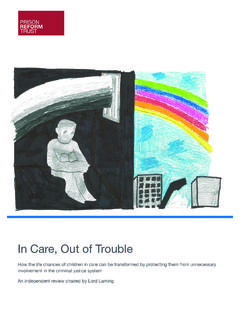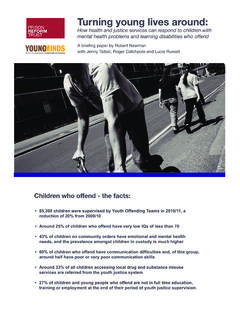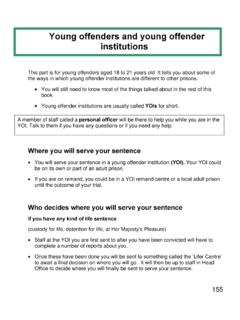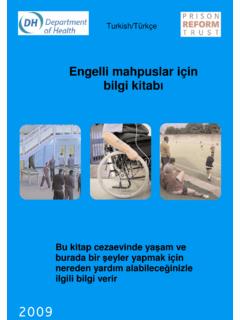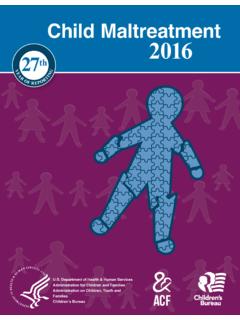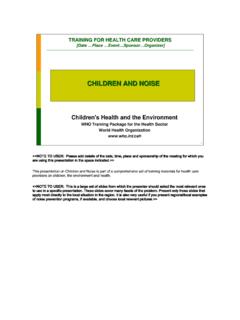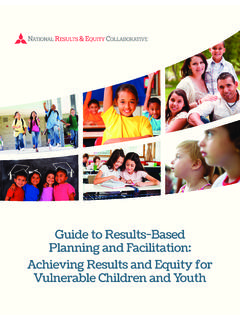Transcription of Seen and Heard - Prison Reform Trust
1 JSeen and HeardJenny Talbotsupporting vulnerable children in the youth justice systemJTYOT reportcover:YOT cover 16/11/2010 15:08 Page 1 The Prison Reform Trust aims to create a just, humane and effective penal system. We do this byinquiring into the workings of the system; informing prisoners, staff and the wider public; and byinfluencing parliament, government, and officials towards Reform . For the last three years thePrison Reform Trust has been running Out of Trouble ( ), a programmewhose aim is to reduce the number of children and young people imprisoned across the UK.
2 Thisprogramme is supported by The Diana, Princess of Wales Memorial Fund over five The AYM (Association of Youth Offending Team Managers Ltd) was set up in 2001 to promote therole and status of YOT Managers and to agree policy initiatives that put young people at the centreof the Youth Justice Diana, Princess of Wales Memorial Fund continues the Princess' humanitarian work in the UKand overseas. By giving grants to organisations, championing charitable causes, advocacy,campaigning and awareness raising, the Fund works to secure sustainable improvements in thelives of the most disadvantaged people in the UK and around the 2010 the authors and Prison Reform TrustAll rights reserved.
3 No part of this publication may be reproduced or transmitted, in any form or byany means, electronic, mechanical, photocopying, recording or otherwise without prior permissionof the copyright report was written by Jenny TalbotFirst published in 2010 by Prison Reform : 0946209 90 1 Photo: Mike by Conquest LithoFor further information, contact:Jenny TalbotPrison Reform Trust15 Northburgh StreetLondon EC1V 0JR020 7251 cover 16/11/2010 15:08 Page 21 Seen and Heard : supporting vulnerable children in the youth justice systemCONTENTSA cknowledgements2 Foreword3 Summary 5 Introduction9 The No One Knowsprogramme9 The Out of Troubleprogramme10 Profile of children who offend 11 Disability discrimination and the inclusion agenda12 Youth justice services13 Structure of this report16 Terminology16 Part one: aims and methods17 Aims of this study17 Methods 17 Part two.
4 The views of YOT staff 21 Identifying impairments and difficulties of children who offend 21 Prevalence of children who offend with impairments and difficulties30 Specialist staff and service provision32 Reasonable adjustments and adapted interventions 40 Difficulties experienced by children 42 Training and support for YOT staff46 Disability equality and statistics 48 Levels of confidence amongst YOT staff48 Custodial sentences 52 Work of which YOT staff were proud and examples of good practice52 YOT staff recommendations for change57 Part three: conclusion61 Main findings61 Concluding discussion64 Part four: recommendations81 References86 Appendices89 Appendix 1: publications from No One 2: publications from Out of 3: check list for youth offending :JTYOT report 17/11/2010 17:32 Page 1 AcknowledgementsThis study is a joint enterprise between the Prison Reform Trust and the Association ofYOT Managers Ltd.
5 The Prison Reform Trust and the Association of YOT Managers Ltd would like to thank allthose who took the time to complete the survey and the heads of service and YOTmanagers who encouraged members of their staff to take part. Special thanks go tomembers of staff at the two YOTs who agreed to pilot the questionnaire, to those involvedin helping with its design and to those who commented on the report in the final stages ofdrafting, in particular: Elizabeth Bowles, policy manager, public sector duties, Equality and HumanRights Commission Fergus Currie, youth offending programme manager, Care Quality Commission Lorna Hadley, chair, Association of YOT Managers Ltd, 2010 Karina Hepworth, senior nurse specialist, learning disabilities, South WestYorkshire Partnership NHS Foundation Trust and Kirklees youth offending team Diz Minnitt, speech and language lead, Association of YOT Managers Ltd andoperational manager, Milton Keynes youth offending team Mike Thomas, chair.
6 Association of YOT Managers Ltd, 2007 10 Ian Warriner, specialist speech and language therapist, NHS Bolton and Boltonyouth offending teamWe are very grateful to The Diana, Princess of Wales Memorial Fund, without whosesupport this study would not have been possible. Finally, thanks to staff and volunteers at the Prison Reform Trust who provided guidanceand support throughout the process. 2 JTYOT reporttextonly:JTYOT report 17/11/2010 17:32 Page 2 ForewordIn December 2007 I was invited by the government to undertake a review of people withmental health problems or learning disabilities in the criminal justice system.
7 What beganas a six month review of the organisation and effectiveness of court liaison and diversionschemes was extended to over 12 months so that a more comprehensive considerationof the offender pathway could be undertaken. The confines of the review, however, didnot allow for the same consideration of children with mental health problems or learningdisabilities in the youth justice system. My report*, published in 2009, contained 82recommendations of which a small number related to children , children s services and theyouth justice system. During my review it was clear that the early identification of children with learningdisabilities or mental health problems and the provision of appropriate treatment andsupport not only have the potential to impact on immediate offending and reoffendingrates, but also to influence children and young people away from an adulthood ofoffending.
8 How well youth justice services identify and support children with mental health problemsor learning disabilities and a number of other impairments and difficulties such asautistic spectrum disorder, attention deficit hyperactive disorder, communicationdifficulties, special educational needs and specific learning difficulties, was the primaryfocus of this study. Youth offending team staff who participated in this study spoke candidly of theirexperiences. Many had positive things to say about work they were proud of. Othersrecounted stories about individual children that they and other YOT staff had overall picture, however, was mixed, and a significant cause for concern.
9 With the possible exception of mental health problems, there was a lack of routinescreening or assessment procedures to identify children s support needs, and informationreceived from children s services such as special educational needs teams and child andadolescent mental health services, was limited. Only around half of YOT staff receivedtraining to help identify when children might have particular impairments and YOT staff generally spoke highly of specialist services and support, manyreported gaps in provision. According to YOT staff, children with impairments and difficulties who offend faceparticular problems.
10 These include, understanding and participating in court proceedings,understanding what is expected of them and the consequences of non-compliance, andmany find it hard to participate in youth justice programmes and activities. The implications for these children are grave, and this is reflected in the view held bymost YOT staff that children with impairments and difficulties were more likely thanchildren without, to receive a custodial sentence. Notwithstanding the above, it is pleasing to see that good work does exist; a number ofYOTs do use screening or assessment procedures to identify children s support needs;information is promptly received from children s services; YOT staff do receive training,and specialist services are readily available, providing guidance to YOT staff and supportfor children .
